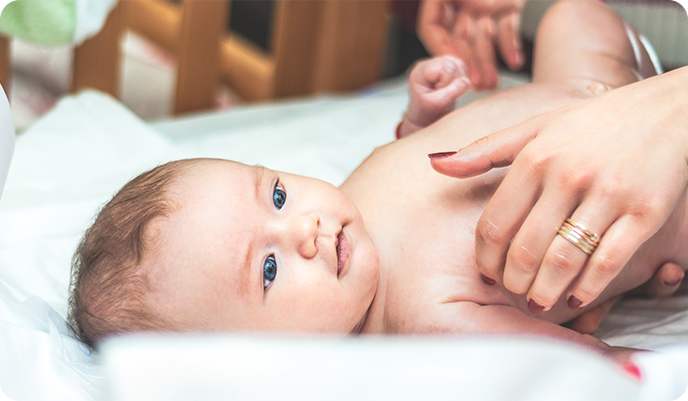A Child's Milestones Between Weeks 4 - 8
Heather Morris, a Registered General Nurse and a State Certified Midwife of over 25 years, provides an overview of a baby's development in the newborn stage of weeks 4 - 8. The below report details milestones babies may be reaching at this age, advice which may be helpful to parents and, potential red flags to look out for.

Overview of Milestones Expected Between Weeks 4 - 8
Motor skills: raises head to 45 degrees in the prone position.
Cognitive development and fine motor skills: holds a rattle or toy when placed in their hands; follows moving object or face by turning their head (fixing and following).
Hearing, Speech and Language Development: gurgles; startles at loud noises; follows a horizontal arc with their eyes.
Social, Emotional and Behavioural Development: starts smiling responsively; awake more during the daytime.

An In-Depth Review of a Baby's Development at 8 weeks
By about four weeks, a baby is likely to start smiling (although some take longer to do this). Smiling in response to faces and social interaction will start to develop. A baby starts learning how to communicate their needs and will cry when hungry or uncomfortable. There is likely to be a preference for familiar faces and a baby will follow a face with their eyes and maintain eye contact for longer than a newborn. Their pupils will react to light and they will follow a pencil light with their eyes. Facial expressions will become increasingly alert and they will stop whimpering and turn towards the sound of a nearby soothing voice. [Sharma, 2014]
When their cheek is touched at the corner of their mouth, they will turn their head to the same side and will try to suck the person’s finger (rooting reflex). Their head will still need to be supported when they are carried, dressed or bathed. [Dosman, 2012].
Nappy rash can develop at any age, even though it’s most common between 9-12 months. Nappies need to be changed frequently (young babies need changing as many as 10 or 12 times a day) and the skin cleaned gently but thoroughly.
Advice which may be useful for parents
By week 8 your baby may start to: notice their surroundings, smile responsively, react to familiar faces and voices, reach out for objects
- Your baby may be busy exploring their body – kicking, waving and trying to grab. If you’re finding their bed covers constantly kicked off, a baby sleeping bag might be the answer.
- It's a good time to introduce simple board books. They will love hearing your voice and looking at the pictures.
- Babies learn very quickly and will respond to sensory-stimulating opportunities, such as brightly coloured toys (babies are captivated by high-contrast patterns), baby play gyms and mobiles.
- Supervised tummy time helps babies develop their neck, chest and arm muscles. This helps them to lift their heads independently and use their forearms to support their upper body. The same muscles also play a role in reaching, sitting and crawling.
- Supervised tummy time without a nappy will also allow the skin to breathe and help avoid nappy rash problems.
Health checks/interventions (weeks 4-8)
A baby will have their first set of vaccinations at eight weeks old and these include:
- The 6-in-1 vaccine is given at 8, 12 and 16 weeks. It protects against diphtheria, polio, hepatitis B, HiB (Haemophilus influenzae type b), tetanus and pertussis (DTaP/IPV/Hib/HepB).
- Pneumococcal conjugate vaccine (PCV) is given at 8 weeks, 16 weeks and 1 year.
- RV (rotavirus) vaccine is given as an oral vaccine in two doses for babies aged 8 and 12 weeks.
- Meningococcal B (MenB) vaccine is recommended for babies aged 8 weeks, 16 weeks and 1 year.
Potential ‘red flag’ warnings (by week 8)
- Has trouble moving eyes or crosses them most of the time.
- Doesn't respond to loud noises.
- Doesn't notice own hands.
- Lack of weight gain.
- Does not cry when hungry or uncomfortable.
- Unable to settle.
- Resists being held.
- Does not enjoy different types of movement.
- Does not make eye contact.
- Fists remain closed most of the time.
- Stiff legs with little or no movement.
- Difficulty lifting their head.
- Problems with feeding and retaining feeds.
Between 4-8 weeks, babies are likely to develop at very different rates and ‘red flag’ indicators tend to be more relevant after 6 months of age.
Reference sources
CF Dosman, D Andrews, KJ Goulden. Evidence-based milestone ages as a framework for developmental surveillance. Paediatr Child Health 2012;17(10):561-568.
Ajay Sharma, 2014, Mary Sheridan's From Birth to Five Years: Children's Developmental Progress 4th Edition
https://www.nhs.uk/conditions/pregnancy-and-baby/nappies/ accessed 16the September 2019
Morris H. Getting to the bottom of nappy rash. Community Pract. 2012 Nov;85(11):37-8.
/Greenbook_chapter_11_UK_Immunisation_schedule.pdf
accessed 18th September 2019




